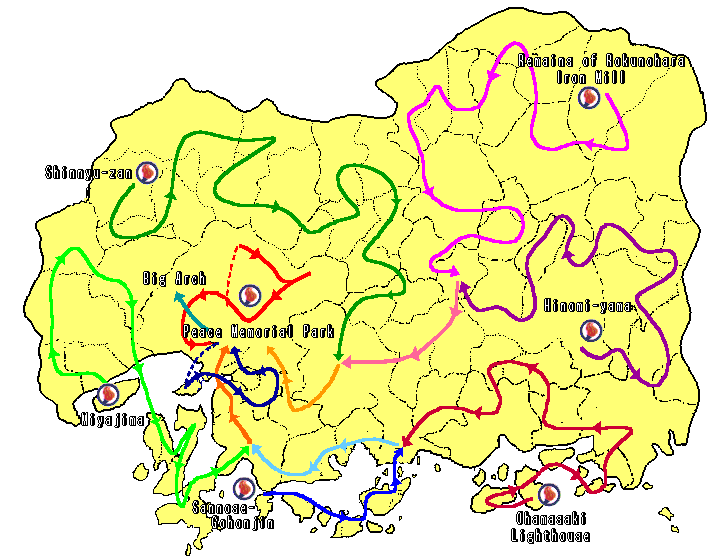(1)Course of the torch


Fire of West Chugoku mountainous district

Fire of Tatara

Fire of Rouman-Bingokokufu

Fire of Lighthouse

Fire of Sea Port

Fire of Miyajima

Fire of Lighthouse & Sea Port

Fire of Chugoku mountainous district

Fire of Seto inland sea

Fire of Tatara, Rouman & Bingokokufu

Murmuring Course of Peace Fire

Ripples Course of Peace Fire

Fire of Hiroshima

The torch of the Hiroshima National Athletic Meeting wanders through the various
prefectural regions.
The torch of the National Athletic Meeting corresponds to the sacred torch of the
Olympic games. The torch will be lighted at 7 places and brought with the prefectural
flag in a relay through all cities, towns and villages brought for the opening ceremony
on October 10 to the Prefectural Government Building, where they are gathered into a single
fire - the Hiroshima fire.
On the day of the opening ceremony, October 12, the fire tower at the ceremony site,
the Hiroshima big arch, will be lighted and then watch throughout the meeting over the hot
fighting for medals.
(2) Ignition
Ignition site
Ignition ceremony site
Ignition method
Description of the ignition etc.
Peace Memorial Park (Hiroshima)
[Ignition ceremony]
[departure ceremony]
Peace Memorial Park
setting fire
Take the fire from the "peace fire" that keeps burning in a wish for eternal peace.
Ohamasaki lighthouse (Innoshima)
[Ignition ceremony]
[departure ceremony]
Innoshima large bridge memorial park
electric ignition
Reconstruction of what was called the "all night fire" that served as a lighthouse for
ships entering or leaving the port during the Edo period.
The electricity generated by a generator will temporarily be stored in an accumulator
and the torch finally ignited through electric heat. Thus, the torch will be ignited at the
ignition part of the "all night fire".
Hinomi-yama
(Fuchu)
[Ignition ceremony]
Hatatate-yama, peak square
[departure ceremony]
Tukimi-ga-oka ground
Fire bow
A rod is rotated in fire bow style to set the torch via the fraction heat on fire.
After naming the torch, it is attached to an RC helicopter to be carried to the departure
ceremony site.
Sannose-Gohonjin
(Shimo-Kamagiri)
[Ignition ceremony]
[departure ceremony]
Gohonjo-mae
Tidal power generation
A water wheel set on the sea surface will generate electricity through the tides at
Sannose-Seto. The heat from the generated electricity will then be used to ignite the torch.
Miyajima
(Miyajima town)
[Ignition ceremony]
[departure ceremony]
Mikasa-hama
Fire started by striking sparks
In the main hall of The Itsukushima shrine the torch will be set on fire by striking
sparks. This fire will then be carried to Mikasa and transferred to the altar of torch
to light the torch.
Shinnyu-zan
(Togouchi town)
[Ignition ceremony]
[departure ceremony]
Shinnyu-zan green shower
Fire transfer
From the mountain burning festival held in spring the flame from the mountain burning
will be preserved for half a year.
During an ethnic art performance of Gagaku a mortar and pistil are used to light a fire
that is then used to burn the mountain and light the torch.
Remains of Rokunohara iron mill
(Saijo town)
[Ignition ceremony]
Kenmin-no-mori
Kanayago square
[departure ceremony]
Kenmin-no-mori
Central square
hot metal
Reconstruction of the balance bellow used for modern cupola steel making. Melting of hot
metal in this cupola to ignite the torch.

 | Fire of West Chugoku mountainous district |
 | Fire of Tatara |
||
 | Fire of Rouman-Bingokokufu |
 | Fire of Lighthouse |
||
 | Fire of Sea Port |
 | Fire of Miyajima |
||
 | Fire of Lighthouse & Sea Port |
 | Fire of Chugoku mountainous district |
||
 | Fire of Seto inland sea |
 | Fire of Tatara, Rouman & Bingokokufu |
||
 | Murmuring Course of Peace Fire |
 | Ripples Course of Peace Fire |
||
 | Fire of Hiroshima |
 |
|
|
|
|
|
|
[departure ceremony] Peace Memorial Park |
|
Take the fire from the "peace fire" that keeps burning in a wish for eternal peace. |
|
[departure ceremony] Innoshima large bridge memorial park |
|
Reconstruction of what was called the "all night fire" that served as a lighthouse for
ships entering or leaving the port during the Edo period. |
(Fuchu) |
Hatatate-yama, peak square [departure ceremony] Tukimi-ga-oka ground |
|
A rod is rotated in fire bow style to set the torch via the fraction heat on fire. After naming the torch, it is attached to an RC helicopter to be carried to the departure ceremony site. |
(Shimo-Kamagiri) |
[departure ceremony] Gohonjo-mae |
|
A water wheel set on the sea surface will generate electricity through the tides at Sannose-Seto. The heat from the generated electricity will then be used to ignite the torch. |
(Miyajima town) |
[departure ceremony] Mikasa-hama |
|
In the main hall of The Itsukushima shrine the torch will be set on fire by striking sparks. This fire will then be carried to Mikasa and transferred to the altar of torch to light the torch. |
(Togouchi town) |
[departure ceremony] Shinnyu-zan green shower
| ||
(Saijo town) |
Kenmin-no-mori Kanayago square [departure ceremony] Kenmin-no-mori Central square |
|
Reconstruction of the balance bellow used for modern cupola steel making. Melting of hot
metal in this cupola to ignite the torch. |